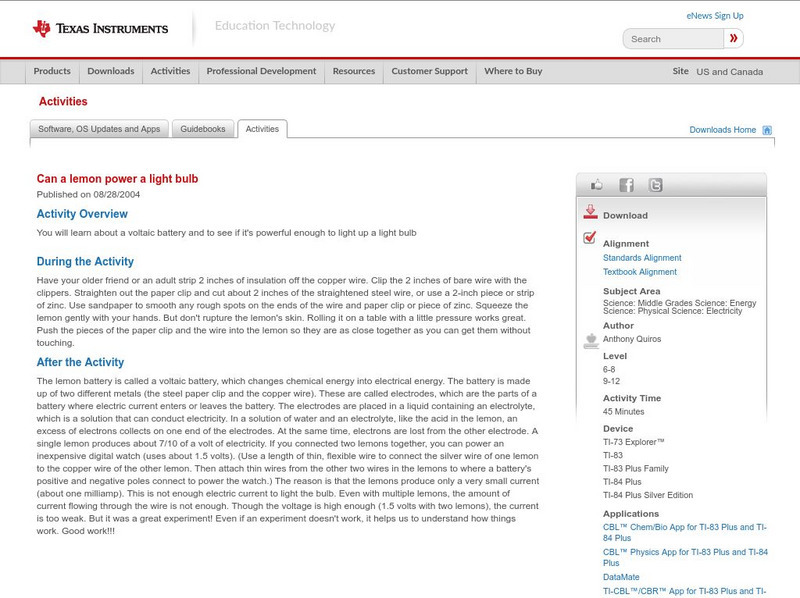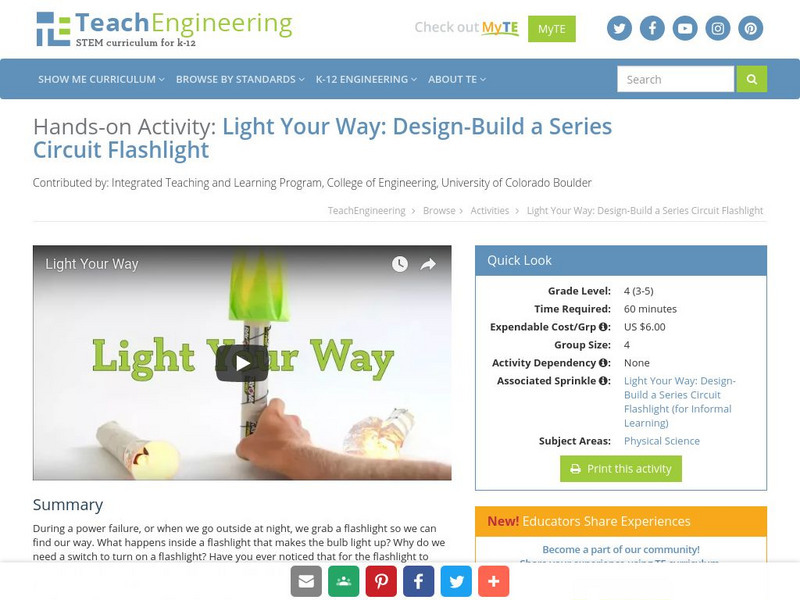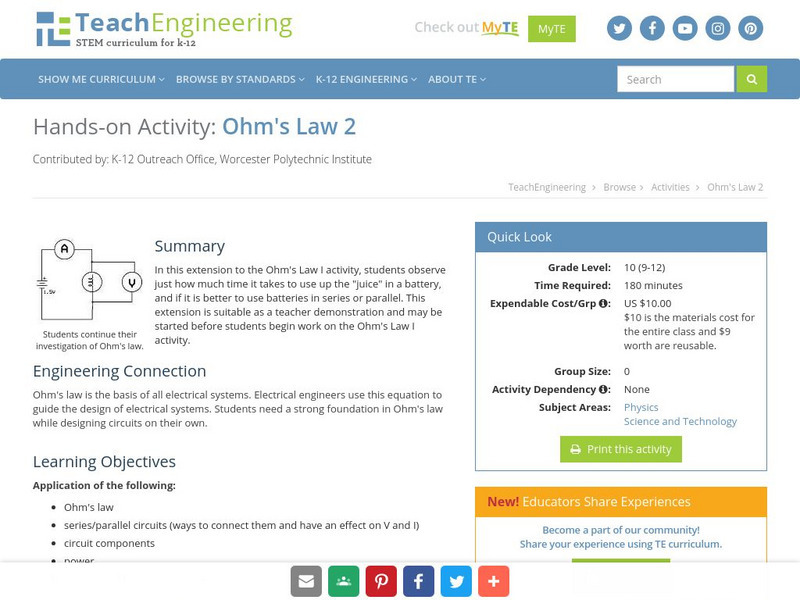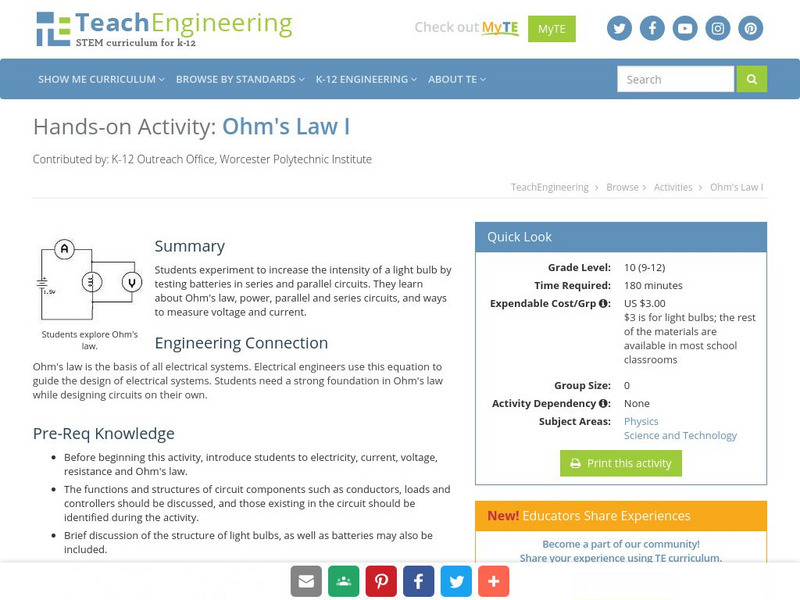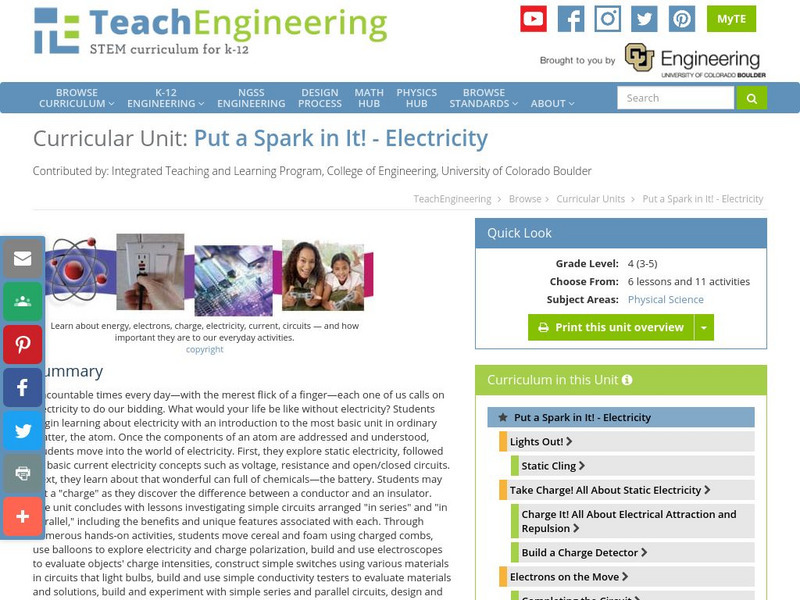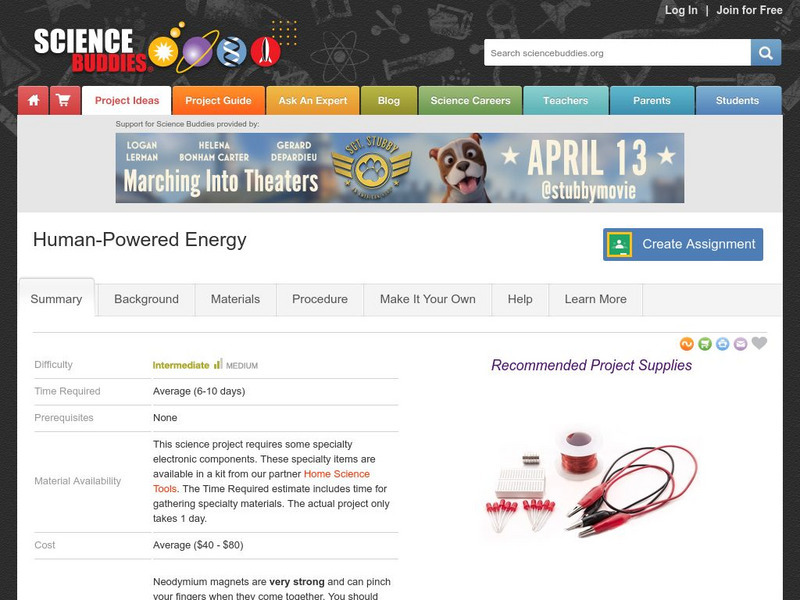Texas Instruments
Texas Instruments: Can a Lemon Power a Light Bulb
You will learn about a voltaic battery and to see if it's powerful enough to light up a light bulb
Smithsonian Institution
Lemelson Center: Thomas Edison's Inventive Life
This site is a complete resource for learning about Edison's life, his inventions, and electricity. If you like experimenting, there are instructions included for how to make your own light bulb. Good photos.
Curated OER
National Park Service: Thomas Edison National Historical Park: Edison Biography
Here is a very detailed biography of Thomas Edison ranging from his boyhood and his work as a telegrapher, moving on to his invention of the phonograph and incandescent light bulb, and finally, a description of his laboratories where he...
Concord Consortium
Concord Consortium: Stem Resources: Heat and Light From Electricity
Understand the energy transformations that happens when you light a bulb with a battery. Activity requires students to build a simple circuit and take temperature and time measurements. Lab includes procedure with questions that can be...
PBS
Pbs Learning Media: Dc Circuit Builder
Play with resistors, light bulbs, wires, switches, a battery, voltmeters, and ammeters in this interactive circuit simulation.
Other
California Science Center: Lemon Light
Try out this great electricity activity by using lemons to make a light bulb glow. You can learn about the science behind the activity and watch an animated demonstration.
University of Colorado
University of Colorado: Ph Et Interactive Simulations: Circuit Construction Kit (Dc Only), Virtual Lab
Build circuits with resistors, light bulbs, batteries, and switches and take measurements with laboratory equipment like the realistic ammeter and voltmeter.
TeachEngineering
Teach Engineering: Light Your Way
When there is a power failure, or when we go outside at night, we grab a flashlight so we can find our way. What happens inside a flashlight that makes the bulb light up? Why do we need a switch to turn on a flashlight? Have you ever...
TeachEngineering
Teach Engineering: Bulbs & Batteries Side by Side
We are surrounded everyday by circuits that utilize "in parallel" and "in series" circuitry. Complicated circuits designed by engineers are made of many simpler parallel and series circuits. In this hands-on activity, students build...
Science Education Resource Center at Carleton College
Serc: Investigating Electricity
In this interactive activity, young scholars will explore electricity and be able to design and create a complete electrical circuit. Students will also learn what is necessary to light a light bulb. Creative thought, ideas, and,...
TeachEngineering
Teach Engineering: Conductivity
Students make a simple conductivity tester using a battery and light bulb. They learn the difference between conductors and insulators of electrical energy as they test a variety of materials for their ability to conduct electricity.
TeachEngineering
Teach Engineering: Potato Power
Students use potatoes to light an LED clock (or light bulb) as they learn how a battery works in a simple circuit and how chemical energy changes to electrical energy. As they learn more about electrical energy, they better understand...
University of Colorado
University of Colorado: Ph Et Interactive Simulations: Circuit Construction Kit
Build circuits with resistors, light bulbs, batteries, and switches. Take measurements with the realistic ammeter and voltmeter. View the circuit as a schematic diagram, or switch to a life-like view.
TeachEngineering
Teach Engineering: Lights On!
Students in this activity will build simple circuits using a battery, wires, and light bulbs. This activity allows students to examine how electricity is conducted through a light bulb using a battery as a power source. Students will...
TeachEngineering
Teach Engineering: Ohm's Law 2
This extension to the Ohm's Law I activity, students will observe just how much time it takes to use up the "juice" in a battery, and if it is better to use batteries in series or parallel.
TeachEngineering
Teach Engineering: Ohm's Law I
Students will work to increase the intensity of a light bulb by testing batteries in series and parallel circuits. It analyzes Ohm's Law, power, parallel and series circuits, and ways to measure voltage and current.
TeachEngineering
Teach Engineering: Completing the Circuit
In the everyday electrical devices we use - calculators, remote controls and cell phones - a voltage source such as a battery is required to close the circuit and operate the device. In this hands-on activity, students use a battery,...
Science Struck
Science Struck: Lemon Battery Experiment
In this step-by-step experiment, you will learn how to make a battery using four lemons and use it to light an LED bulb.
University of Colorado
University of Colorado: Ph Et Interactive Simulations: Circuit Construction Kit (Dc Only)
An electronics kit in your computer! Build circuits with resistors, light bulbs, batteries, and switches. Take measurements with the realistic ammeter and voltmeter. View the circuit as a schematic diagram, or switch to a life-like view....
Other
Think Green: Think Waste Management
Find out how waste can be recycled and what you can do to aid recycling efforts in your community. With complete overviews of the types of materials that can be recycled: e-waste, paper and cardboard, metals, glass, plastics,...
TeachEngineering
Teach Engineering: Put a Spark in It! Electricity
Uncountable times every day "with the merest flick of a finger"each one of us calls on electricity to do our bidding. What would your life be like without electricity? Students begin learning about electricity with an introduction to the...
Science Buddies
Science Buddies: Shaking Up Some Energy
Shake N' Light flashlights have been advertised on televisions across the nation in the recent year. But many do not understand just how they get energy to light up the bulb without using batteries. Do this experiment to make your own...
Science Education Resource Center at Carleton College
Serc: Investigating Electricity: Building Circuits in Elementary Science Class
In this exploration activity, students compare the difference between series circuits and parallel circuits using wire, light bulbs, and D batteries.
University of Virginia
Uva Virtual Lab: Resistors and Capacitors and High Voltage
In this simulation a battery will be used to charge a capacitor. The capacitor will then be used to operate a light bulb until the capacitor is discharged.


